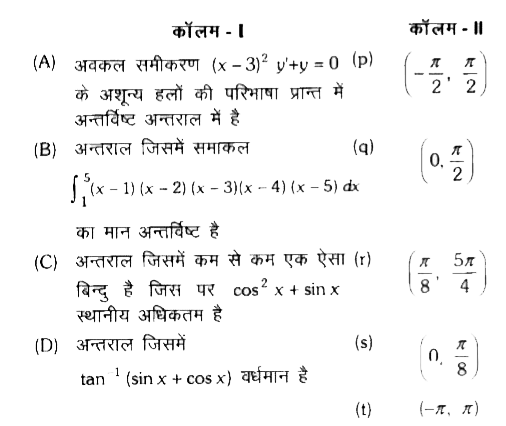यदि y=cot−1[√1+sinx+√1−sinx√1+sinx−√1−sinx], तब dydx=
12
23
3
1
The correct Answer is:A
Step by step video, text & image solution for यदि y=cot^(-1)[(sqrt(1+sinx)+sqrt(1-sinx))/(sqrt(1+sinx)-sqrt(1-sinx))], तब (dy)/(dx)= by Maths experts to help you in doubts & scoring excellent marks in Class 12 exams.
Topper's Solved these Questions
- BOOK - ERRORLESS HINDICHAPTER - अवकलन तथा अवकलज के अनुप्रयोगEXERCISE - JEE Advanced (More than oen correct answers)44videos
अवकलन तथा अवकलज के अनुप्रयोग
- BOOK - ERRORLESS HINDICHAPTER - अवकलन तथा अवकलज के अनुप्रयोगEXERCISE - JEE Advanced (Reasoning thye questions)26videos
अवकलन तथा अवकलज के अनुप्रयोग
- BOOK - ERRORLESS HINDICHAPTER - अवकलन तथा अवकलज के अनुप्रयोगEXERCISE - MULTIPLE CHOICE QUESTIONS (रोले की प्रमेय, लेग्रांज की मध्यमान प्रमेय )26videos
अवकलन तथा अवकलज के अनुप्रयोग
- BOOK - ERRORLESS HINDICHAPTER - अवकल समीकरण EXERCISE - JEE Advanced ( Matrix Match type questions )3videos
अवकल समीकरण
- BOOK - ERRORLESS HINDICHAPTER - केन्द्रीय प्रवृत्ति के मापEXERCISE - Jee Advanced (Reasoning )2videos
केन्द्रीय प्रवृत्ति के माप
Similar Questions
फलन f(x)=xcos1x,x≥1 के लिए
03:46View Solutionमाना f(x)=2+cosx , सभी वास्तविक x के लिए कथन - 1 : प्रत्येक वास्तविक t के लिए , [t,t+π] में एक बिंदु c का अस्तित्व इस प्रकार है कि f'(c)=0. क्योंकि
कथन -2 f(t)=f(t+2π) प्रत्येक वास्तविक t के लिए।04:11View Solutionमध्यमान प्रमेय f(b)−f(a)=(b−a)f'(c) यदि a=4,b=9 तथा f(x)=√x हो, तो c का मान है
04:01View Solution 05:50View Solution
05:50View Solutionकथन - 1 : प्रथम n सम धन पूर्णांकों का प्रसरण n2−14 है।
कथन - 2 : प्रथम n धन पूर्णाको का योगफल n(n+1)2 और प्रथम n धन पूर्णांको के वर्गों का योगफल n(n+1)(2n+1)6 है।04:02View SolutionFind (dy)/(dx) of y=cot^(-1)[(sqrt(1+sinx)+sqrt(1-sinx))/(sqrt(1+sinx)-sqrt(1-sinx))]
02:49View SolutionIf y=cot−1[√1+sinx+√1−sinx√1+sinx−√1−sinx](0<x<π/2), then dydx=
06:50View SolutionIf y=tan−1(√1+sinx+√1−sinx)(√1+sinx−√1−sinx), find dydx.
03:32View Solutiondy/ dx ज्ञात कीजिए y=cot−1[√1+sinx+√1−sinx√1+sinx−√1−sinx]
08:24View Solutiondydx ज्ञात कीजिए, यदि-
y=tan−1{√1+sinx+√1−sinx√1+sinx−√1−sinx}05:41View Solutiondydx ज्ञात कीजिए, यदि-
y=cot−1{√1+sinx+√1−sinx√1+sinx−√1−sinx}03:44View SolutionIf coty=√1+sinx+√1−sinx√1+sinx−√1−sinx, then dydx=
06:33View SolutionProve that cot−1[√1+sinx+√1−sinx√1+sinx−√1−sinx]
05:11View Solutiony=cot−1(√1+sinx+√1−sinx√1+sinx−√1−sinx),f∈ddydx.
05:53View SolutionIf y=cot−1[√1+sinx+√1−sinx√1+sinx−√1−sinx](0<x<π/2), then dydx=
04:17View SolutionIf y=cot−1{√1+sinx+√1−sinx√1+sinx−√1−sinx}. Show that dydx is independent of x.
05:28View Solution

